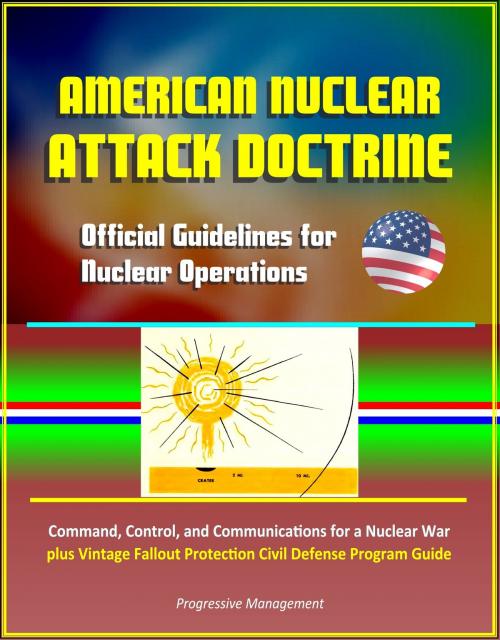American Nuclear Attack Doctrine: Official Guidelines for Nuclear Operations, Command, Control, and Communications for a Nuclear War, plus Vintage Fallout Protection Civil Defense Program Guide
Nonfiction, History, Military, Nuclear Warfare, Aviation| Author: | Progressive Management | ISBN: | 9781370749034 |
| Publisher: | Progressive Management | Publication: | September 24, 2017 |
| Imprint: | Smashwords Edition | Language: | English |
| Author: | Progressive Management |
| ISBN: | 9781370749034 |
| Publisher: | Progressive Management |
| Publication: | September 24, 2017 |
| Imprint: | Smashwords Edition |
| Language: | English |
Here is the official U.S. Air Force (USAF) doctrine for nuclear war, addressing the issue of command and control, and clearly stating that only the President can make explicit orders to employ nuclear weapons at any level. This doctrine document was updated in 2015.
Air Force nuclear forces consist of delivery systems; nuclear command, control, and communications (NC3) capabilities; personnel; and the physical infrastructure for sustainment. Intercontinental ballistic missiles (ICBMs) and dual-capable bombers and fighters are the Air Force's delivery platforms. Combined with the Navy's submarine-launched ballistic missiles (SLBMs) and other assets, these forces form the nuclear triad. Each nuclear-capable system offers distinct advantages. SLBMs offer survivability whereas ICBMs are the most responsive, offering prompt, on-alert capability combined with dispersed fielding; also, attacks on ICBMs are unambiguous attacks against the United States. Dual-capable bomber and fighter aircraft offer mission flexibility and a capability to provide distinct signaling in a crisis through posturing to alert and through shows of force.
Deterrence, extended deterrence, assurance, dissuasion, and defeat stem from the credibility of our nuclear capabilities in the minds of those we seek to deter, assure, or dissuade. The objectives of deterring adversaries and assuring allies require visible and credible nuclear capabilities. This credibility is attained through focused day-today training, periodic exercises, and regular inspections which underpin the credibility of US nuclear capability.
As a bonus, this reproduction also includes the historic vintage 1961 civil defense document about radioactive fallout and shelters. Written during the most dangerous days of the Cold War, this guide was designed to advise Americans on what to do after a thermonuclear attack. The text reads: "There is no escaping the fact that nuclear conflict would leave a tragic world. The areas of blast and fire would be scenes of havoc, devastation, and death. For the part of the country outside the immediate range of the explosions, it would be a time of extraordinary hardship—both for the Nation and for the individual. The effects of fallout radiation would be present in areas not decontaminated. Transportation and communication would be disrupted. The Nation would be prey to strange rumors and fears. But if effective precautions have been taken in advance, it need not be a time of despair. These are somber subjects, and they presuppose a catastrophe which can be made very unlikely by wise and positive policies, pursued with imagination and faith. Still, realistic preparation for what might happen is far more useful than blindness, whether from fear or ignorance. A sane and sober person can assume that, whatever comes to pass, he would draw on his reserve of courage and intelligence—and the unquenchable will to live—and begin to build again."
Here is the official U.S. Air Force (USAF) doctrine for nuclear war, addressing the issue of command and control, and clearly stating that only the President can make explicit orders to employ nuclear weapons at any level. This doctrine document was updated in 2015.
Air Force nuclear forces consist of delivery systems; nuclear command, control, and communications (NC3) capabilities; personnel; and the physical infrastructure for sustainment. Intercontinental ballistic missiles (ICBMs) and dual-capable bombers and fighters are the Air Force's delivery platforms. Combined with the Navy's submarine-launched ballistic missiles (SLBMs) and other assets, these forces form the nuclear triad. Each nuclear-capable system offers distinct advantages. SLBMs offer survivability whereas ICBMs are the most responsive, offering prompt, on-alert capability combined with dispersed fielding; also, attacks on ICBMs are unambiguous attacks against the United States. Dual-capable bomber and fighter aircraft offer mission flexibility and a capability to provide distinct signaling in a crisis through posturing to alert and through shows of force.
Deterrence, extended deterrence, assurance, dissuasion, and defeat stem from the credibility of our nuclear capabilities in the minds of those we seek to deter, assure, or dissuade. The objectives of deterring adversaries and assuring allies require visible and credible nuclear capabilities. This credibility is attained through focused day-today training, periodic exercises, and regular inspections which underpin the credibility of US nuclear capability.
As a bonus, this reproduction also includes the historic vintage 1961 civil defense document about radioactive fallout and shelters. Written during the most dangerous days of the Cold War, this guide was designed to advise Americans on what to do after a thermonuclear attack. The text reads: "There is no escaping the fact that nuclear conflict would leave a tragic world. The areas of blast and fire would be scenes of havoc, devastation, and death. For the part of the country outside the immediate range of the explosions, it would be a time of extraordinary hardship—both for the Nation and for the individual. The effects of fallout radiation would be present in areas not decontaminated. Transportation and communication would be disrupted. The Nation would be prey to strange rumors and fears. But if effective precautions have been taken in advance, it need not be a time of despair. These are somber subjects, and they presuppose a catastrophe which can be made very unlikely by wise and positive policies, pursued with imagination and faith. Still, realistic preparation for what might happen is far more useful than blindness, whether from fear or ignorance. A sane and sober person can assume that, whatever comes to pass, he would draw on his reserve of courage and intelligence—and the unquenchable will to live—and begin to build again."















